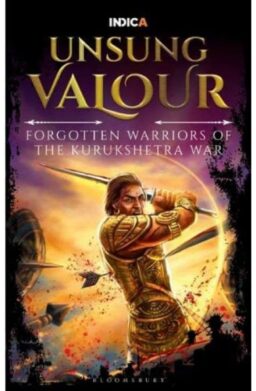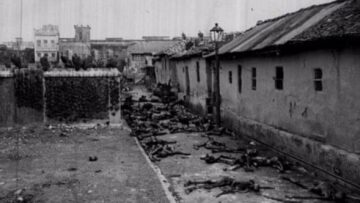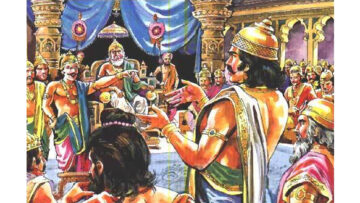Unsung Valour is a truly modern literary endeavour. A twitter thread by the curator of this anthology (and noted author) Sai Swaroopa Iyer in which she statistically documented the various clashes across the 18 days of the Great War at Kurukshetra, became the catalyst for the book.
Indic Academy invited authors to submit short stories of the lesser-known battles of the Kurukshetra war. The final outcome of the exercise was this collection of short stories designed to shed light on several secondary and peripheral characters in the Mahabharata.
The book contains ten stories from ten different authors, each from a vastly different background. As such, the reader is presented with an extremely interesting spectrum of narrative styles, perspectives and points of view.
However, this diversity of treatment is well balanced by the thematic unity that binds the anthology together, namely the vortex of destruction that was the all-consuming Great War.
The most unique thing about this book is that it contains tales told from the perspective of both the Pandavas and the Kauravas. This creates a refreshing back and forth as the reader gets to experience the same events from a multitude of viewpoints.
The result is not unlike reading the newspapers (or should we say social media timelines) of two countries at war – we get a beautiful contrast of emotions that really fleshes out what certain events means to the characters on both sides of the divide at a human, moral and political level.
The book starts off with the story of Iravan, the son of Arjuna and the Naga Princess Ulupi. It is a fast paced, straightforward tale infused with veera rasa – the valour and the devotion of the young prince shining beautifully amidst the carnage of the battlefield.
A special mention must be made to the sections which elegantly fuses the practical battle tactics with the supernatural maya that many of the combatants were using.
We then encounter the thoughts of Shakuni in what is the standout story of the collection. The author has dived into the psyche of the evil mastermind whose manipulations were instrumental in igniting the civil war.
What is particularly heartening to see was that there have been no efforts to justify the evil deeds done by the Gandhara King – indeed it is commendable that the author hasn’t fallen into the trap many modern commentators do in trying to defend the indefensible in the name of “humanizing” a villain.
What the reader will experience is the scale of ruthless ambition and bone chilling malice that drove Shakuni in his actions, as well as the almost Shakespearean manner in which his own subconscious began to disintegrate under the pressures of his adharmic acts.
The next story delves into the mind of another well-known villain, the Sindhu King Jayadratha. We accompany the man during one of the most critical episodes of the war – the killing of Abhimanyu within the Chakravyuha. Jayadratha comes across as the petty man who gets a chance to wield disproportionate power, and in that power drunk state opens the door to tragedy for all concerned including himself.
We switch back again to the Pandava side in the next story, told from the perspective of Ghatotkacha, the Rakhshasa born son of Bhima. This story contains exquisite details on the Rakhshasa culture as it coexisted with the other civilizations of Bharata.
It is also commendable that the author has shown a second layer of relationship – that of Ghatotkacha with his son – which readers don’t normally encounter in other retellings. This is a story told with great sensitivity and respect to Bhima’s union with Hidimba.
We then meet Prativindhya, the eldest of the Upapandavas, the children of Draupadi, in a tale that gives us a delightful insider look at the family dynamics of the Pandava clan. Our hero is not as famous as his illustrious cousins, yet his perspective is invaluable to add dimensionality to the war – these were real people with real families who were marching out to face death in the company of their blood relatives and clansmen.
We again switch back to the Kaurava side to meet the grizzled elephant warrior, Bhagadatta. The Asura king of Pragjyotisha’s duel with Arjuna is one of the highlights of the war – an episode which demonstrated the former’s might, the latter’s unmatched skill and finally Shri Krishna’s divinity.
We are also introduced to the war elephant Supratika, and experience first-hand the ferocious capacity for violence that the elephant corps of ancient Indian armies possessed. This is another story that manages to evoke the veera rasa in the reader.
A rip-roaring yarn documenting the “surgical strike” of Arjuna to keep his vow of killing Jayadratha follows in the best military thriller tradition. Narrated by the veteran Panchala warrior Yudhamanyu, the language of this story is earthy, salty and very unique in the Mahabharata setting. This is another story which does a beautiful job of shedding light to some of the political dimensions of the war, as well as give a common man’s perspective on the entire affair.
We again meet Ghatotkacha in the next story – but this time the focus of the narrative becomes his position in the kuru clan, the baggage of his Rakhshasa background, and his relationship with his extended family, especially his cousin Abhimanyu.
The latter part is mentioned in the Balinese as well as the Javanese versions of the Mahabharata, as well as in folk tales like Sasirekha Parinayam (which probably served as inspiration for the telugu hit MayaBazar).
This story is able to beautifully capture the nuance of Ghatotkacha’s struggles to balance his Rakhshasa heritage with his position as a member of the Kuru clan, the complex dynamics of the Rakhshasa society whose brunt has to be borne by his mother, as well as the question of indigenous tribes changing their lifestyles by accepting “civilization”. The beautifully woven backstories are a testament to the author’s grasp on the source material.
The penultimate story of the collection is based on Yuyutsu – the only son of Dhritarashtra to survive the Great War. We witness his moral conflict and then his courage as he abandons his own half-brothers to side with the Pandavas for the sake of Dharma. This tale takes a narrative departure midway and gives us the briefest of looks at some of the post-war developments.
The anthology concludes with yet another fast-paced account from Jayadratha’s perspective of the day of the Chakravyuha and subsequently Arjuna’s vow. The youthful exuberance of the narration carries the story forward at a breakneck pace. The nuggets of insight contained within the tale are all the more impressive considering the author’s young age.
From time immemorial, Mahabharata has been the grand river to which authors, poets, storytellers, painters and moviemakers have continued to pay their tributes, at once imbibing and enriching the flowing nectar whose source is Veda Vyasa’s divine composition. To inherit this legacy is a great privilege as well as a great responsibility. Like our ancestors, we too need to tell the tale of victory of Dharma over Adharma in our own way so that our next generation is able to imbibe the values and the lessons that are contained within the epic.
Unsung Valour continues this glorious tradition in a contemporary manner. The book is clearly targeted to the modern Mahabharata aficionado – indeed one of the limited criticisms of the collection might be the fact that it assumes the reader to be well versed with the core Mahabharata storyline and plot points.
The other criticism might be the recurrence of certain characters like Jayadratha and Ghatotkacha as protagonists – while the treatment is sufficiently different in each case, nonetheless certain readers might find it to be an odd choice to include these.
The wide variance in writing style and narrative constructions is a result of this being an anthology of works by many authors – and I personally think that this is something that enriches the reading experience and keeps the book interesting.
However, the greatest strength of this book is the wholehearted love for the epic that shines forth from each story. It is this love that elevates the tales into ‘katha’ territory – one hopes that in the near future these stories shall burst forth from the confines of these pages and become a part of the larger Mahabharata corpus that occupies a space in the public imagination.
The Mahabharata is a timeless jewel. Each one of us can (and should) pick it up and examine it in the light of his or her own perception. As our own knowledge increases, the jewel shines brighter and brighter, and we begin to see glints of fresh insight emerge from the infinite reservoir of wisdom that is contained within the epic.
It is this light of awareness that has sustained the Bharatiya civilization for millennia. It is our duty and our responsibility to ensure that we are able to pass on this light to our next generation. Unsung Valour is a great step towards this civilizational goal.
Unsung Valour: Forgotten Warriors of the Kurukshetra War is available on Amazon.
Disclaimer: The opinions expressed in this article belong to the author. Indic Today is neither responsible nor liable for the accuracy, completeness, suitability, or validity of any information in the article.











